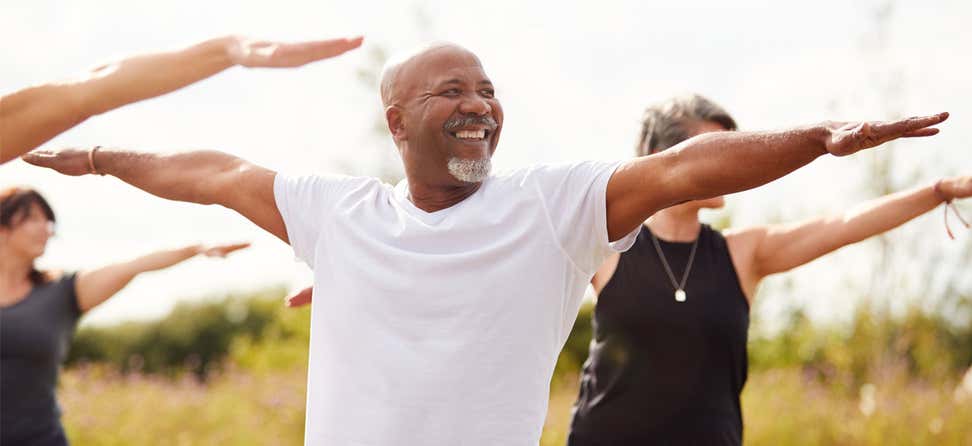Key Takeaways
A coalition is a group of individuals and/or organizations with a common interest that agree to work together towards a common goal.
Falls prevention coalitions can bring together organizations and providers that need to collaborate to reduce falls, identify state or community needs, recommend policy changes, and build capacity.
This document highlights the opportunities and advantages of forming a falls prevention coalition and includes examples of goals and activities that are commonly conducted by state falls prevention coalitions around the country.
A coalition is a group of individuals and/or organizations with a common interest that agree to work together towards a common goal (KU Workgroup for Community Health and Development, 2015). Falls prevention coalitions typically have the common goal of reducing older adult falls, fall-related injuries, and deaths in their communities or states. Since no single organization is responsible for addressing all aspects of falls prevention, coalitions can bring together organizations and providers that need to collaborate to reduce falls, identify state or community needs, recommend policy changes, and build capacity (Fall Prevention Center of Excellence, 2015).
The Falls Free® State Coalitions on Fall Prevention Workgroup members report that developing a state or local coalition to address falls and fall related injuries offers a variety of opportunities and advantages, including:
- Providing a common forum for diverse organizations to address the falls.
- Fostering trust and communication among member organizations.
- Creating a nonpartisan forum for addressing fall prevention on a community level.
- Providing opportunities for a variety of stakeholder contributions.
- Raising public awareness across multiple stakeholders.
- Fostering the maximization of state and local resources.
- Identifying gaps in resource utilization and allocation to target infrastructure building efforts.
- Building upon current ongoing efforts.
- Deterring duplication of efforts.
Although every state or community falls prevention coalition is different, some common goals and example activities include the following:
- Increasing the availability and accessibility of community fall prevention programs and services. Many state and local falls prevention coalitions are educating their members about the evidence-based falls prevention programs that are available, helping to promote the programs, identifying locations to offer the programs, connecting partners that could help make referrals to programs, and providing other support to increase the availability accessibility of programs and services.
- Increasing awareness of the issue and of the effective prevention strategies among stakeholders. To increase awareness, Falls Prevention Coalitions frequently sponsor Falls Prevention Awareness Day, host a fall prevention website, host falls prevention educational presentations, and promote falls prevention through traditional and social media.
- Building and leveraging an integrated, sustainable fall prevention network. Common activities to build and leverage fall prevention networks include coalition members promoting fall prevention within their own organizations, promoting new internal and external partnerships, establishing partnerships and venues where older adults are served, and supporting the development of local/community fall prevention coalitions.
- Increasing provider participation in fall prevention practices. Activities to increase provider participation in fall prevention practices might include promoting fall prevention screening to healthcare providers for all adults age 65 years and older, encouraging the implementation and dissemination of the CDC’s STEADI toolkit for health care providers, and working with professional associations to recognize and promote fall prevention intervention as a priority of professional practice.
- Enhancing data surveillance collection, analysis and data systems linkages. Example activities to enhance data surveillance collection include producing user-friendly profiles about the impact and cost of falls among older adults in the state/community, identifying key data resources and partnering with data managers to improve the capture and quality of data deemed important to fall prevention, tracking fall prevention programs implemented by various agencies across the state, and tracking the numbers of participants in fall prevention programs across the state.
- Improving fall prevention activities in places where older adults reside. Many states are focusing on improving fall prevention activities in nursing homes and assisted living facilities in addition to improving home safety for community-dwelling older adults. Activities might involve education individuals and agencies about fall prevention programs, working with agencies to promote fall prevention programs in long-term care facilities, and encouraging the appropriate use of vitamin D for residents.
- Instituting ongoing evaluation of state efforts and outcomes. Evaluating the efforts and outcomes of falls prevention activities helps to increase impact and address areas for improvement. In some states, the Department of Public Health is developing, implementing, and monitoring evaluation as a function of its epidemiological activities or the State Falls Prevention Coalition may have a mechanism (such as an evaluation committee or evaluator) to evaluate its efforts.
- Increasing funding opportunities and investments for fall prevention. Several states and community falls prevention coalitions have supported the pursuit of funding opportunities such as grants, use of Title IID funds for falls prevention activities, and encouragement of local health departments, trauma centers, or other pertinent organizations to include falls prevention activities in their budgets.
In many states and communities, significant progress had been made in the areas of increasing fall prevention awareness and creating multidisciplinary networks. However, to achieve systems change and long-term sustainability, implementing policy change is necessary. According to the World Health Organization, policies are needed to effectively address the growing problem of falls in an aging society to “provide vision, set priorities and establish institutional standards. Such policies should facilitate capacity building unique to each setting by supporting the generation of new research, encouraging broad collaboration and maximizing availability of resources” (World Health Organization, 2007). Fall prevention policies differ across states, given available resources, the political climate, perceived importance of the issue, and stakeholder interest in and passion for older adult falls prevention. The 2015 Falls Free® National Falls Prevention Action Plan provides many key recommendations and strategies that state or local falls prevention coalitions could pursue.
If your state or community is interested in forming a falls prevention coalition, be sure to review A Practical Guide to State Coalition Building. Also feel free to contact the National Falls Prevention Resource Center (fallsfree@ncoa.org) for technical assistance.
Sources
1. Falls Prevention Center of Excellence. (2015). Coalitions/networks. Found on the internet at http://stopfalls.org/coalitionsnetworks/KU
2. Starting a coalition. Lawrence, KS: University of Kansas. Found on the internet at http://ctb.ku.edu/en/table-ofcontents/assessment/promotion-strategies/start-a-coaltion/main
3. World Health Organization. (2007). WHO global report on falls prevention in older age. Found on the internet at http://www.who.int/ageing/publications/Falls_prevention7March.pdf









